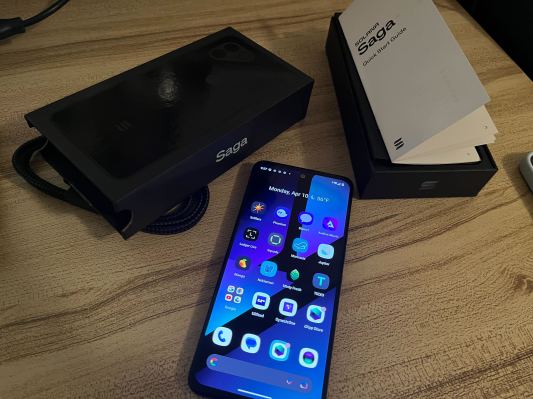Last month, Solana Mobile’s flagship web3 smartphone, the Saga, sold out. Last week the Solana Labs’ subsidiary launched its second phone and got over 40,000 preorders in less than a week. But the company is not slowing down anytime soon.
“After Saga sold out, it felt like there’s an opportunity and the timing in the market was right,” Anatoly Yakovenko, co-founder of Solana Labs, said on TechCrunch’s Chain Reaction podcast. “The timing [for the new phone] worked out right around that moment.”
And if the second device is a success, there will be a third phone launched later on, Yakovenko hinted. Web3 mobile phones are not a punchline, in other words, but a potential growth category.
But Solana Mobile’s road to growth wasn’t an easy one. Its first Saga handset didn’t see much demand when it launched mid-2023 at $1,000. It soon lowered the price to $599 in light of weak demand.
Saga’s fortunes improved after crypto users noticed the dog-centric memecoin BONK’s decentralized app (dApp) provided Saga owners with 30 million of its tokens for free, which was valued around the same price as the phone at the time. The Saga then sold out quickly.
“I think crypto was going through a hard bear market, and the Solana ecosystem was feeling the worst of it,” Yakovenko said. “We were looking for more devs to go to launch and I would say [we were] kind of in survival mode because during that chasm of despair you just need to survive until something like macro [turns the market] around.”
Even then, about 20 to 30 Saga devices were sold a day, which Yakovenko acknowledges wasn’t a lot, but still showed interest from the blockchain’s participants. Now, Saga’s 20,000 units are sold out. In contrast, over 40,000 Chapter 2 Android-based web3 phones have been preordered. The Chapter 2 device is being sold at a $450 price point, making it a cheaper, more accessible option compared to Saga, potentially aiding its sales.
The new device being cheaper is not an accident. Flat-screen TVs once cost thousands of dollars when they first came to market, but now someone can go to a store and get one for a couple hundred dollars. Every year, technology can become cheaper and have higher quality, Yakovenko argued. “We’re basically trying to build a compelling device at breakeven costs and at $450 I think we can accomplish that.”
Yakovenko hopes that if it can reach 25,000 to 50,000 users actively using the dApps through Solana Mobile’s store, then it can become a very compelling user base for projects and developers alike to build for.
Solana Mobile’s recent success selling its new smartphone doesn’t mean that its business fortunes are guaranteed. “I hope it’s not a money pit,” Yakovenko said. “It’s really, really hard to build hardware, and I think we can break even, that’s kind of my hope without accounting for engineering costs, but just within the device itself.”
In order to hit that mark, Solana Mobile will have needed to sell over 250,000 units annually, Yakovenko estimated. Then it can start thinking about the products as a profitable revenue stream, but the building hardware, costs and so on make it hard to do that at the start.
But before that amount, Chapter 2’s target is to sell 100,000 units.
“There’s clearly demand from the crypto user base for this new device and new platform,” Yakovenko said. If Solana Mobile’s devices have 100,000 users, Yakovenko views that user base as a stronger distribution channel for dApps than through traditional app stores like Google or Apple.
Mission possible?
During the episode, Yakovenko reiterated his stance that one of Solana Mobile’s biggest missions is to go up against Google and Apple, something he previously shared at Disrupt 2022.
He said the current phone market is very saturated and thinks there should be more competition, especially for dApps looking to avoid the 20% to 30% tax Google and Apple implement through their app stores, respectively. “It’s really hard to compete with those platforms because they have such a lock in and distribution.”
But when the average phone user is buying something on their device, they aren’t going to shop around for the best price for an in-game asset or other nominal purchases; they’re going to buy what’s in front of them. “That’s the hard part: giving those users an incentive to go buy this device,” Yakovenko said.
Typically, it’s a pretty hard mindset to switch, but developers and crypto users are more likely to seek out those opportunities elsewhere in exchange for better monetization, rates and so on, he said.
Yakovenko questioned whether the smartphone could create incentives that were strong enough for a user to change their behavior — and with the rewards given to Saga holders, it might be possible. Although it took a while for the Saga device to sell out, it had “instant traction” with developers, he added.
If there’s a loop of developers building dApps and people have fun with those apps through the phone, then there’s a snowball effect, Yakovenko said. “Then we can start to talk about how big is this distribution channel, [can] this device line be better than breakeven and actually be profitable and stuff like that.”
But Yakovenko is a realist. “There’s a million ways for us to fail,” he said. He compared Solana Mobile’s demand to the Domino Effect meme, where one small domino falls and later creates a massive effect on the others. But in this case, the BONK token airdrop is the little domino and breaking the app store duopoly is the biggest domino, he added.
“We really want to build this open platform for developers that’s crypto friendly,” Yakovenko said. “There’s a huge opportunity to undercut the fees that both Google and Apple charge.” As the market heats up in crypto, now is the time to “move fast to capture the moment,” he added.
